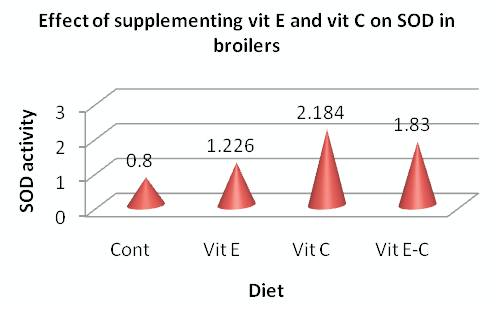Broiler diet and heat stress tolerance in poultrySupplementation of betaine increased the activity of antioxidant enzyme (GPx) and feed efficiency in broilers. Fortification of diet with extracts of Tulasi plant and Amla fruit significantly reduced lipid peroxidation and enhanced the activity of anti-oxidant enzyme (GPx) in broilers during summer season. Dietary supplementation of KCl at 0.1% significantly increased feed efficiency in WL layers during summer season.Maintaining a minimum level of 280 meq/kg dietary electrolyte balance (DEB) is essential in commercial broiler diet for better feed efficiency. Supplementation of vitamin E (250mg), vitamin C (250mg) or their combination significantly increased the activity of super oxide dismutase in broiler chicken. Supplementation of Se (0.30mg/kg), Cr (2000 mcg/kg) or Zn 940 mg/kg) significantly increased performance and activity of anti-oxidant enzymes (catalase and GPx) in broilers during summer. Heat stress and semen quality in poultry:Evaluation of semen quality of Dahlem Red males incubated at normal and high temperature (2oC higher than normal) during 29 and 39 weeks of age revealed that the males from higher incubation temperature (HT) group had significantly (P<0.05) higher sperm concentration. The abnormal sperm percentage was significantly (P<0.05) lower in the higher incubation temperature group. An insemination trial (100 million sperms/bird) on respective group females for five weeks indicates higher hatchability in HT group. The results indicate that exposure of eggs to higher incubation temperature (2oC higher than normal) improves the semen quality. Heat shock proteins and thermal adaptation in poultry:Significant variation in the Hsp70 expression was observed in the breeds (Naked neck, PB-2 and Dahlem Red ) at 2nd and 4th week due to exposure to 2oC increased Back
|

 incubation temperature for 3 h each on 16th, 17th and 18th day of incubation.At day old, the expression of Hsp 70 was almost similar in all the three breeds which might be because of the reason that the chicks have not been exposed to the ambient temperatures for sufficient time. At 2nd and 4th weeks of age, significant breed variation was observed. The Hsp70 expression was highest in PB-2 followed by Dahlem Red and naked neck chicken, indicating the better heat tolerance of the naked neck birds. Differential tissue expression of the Hsp 70 was noticed in the tissues. At all ages and in all the breeds studied, the spleen exhibited highest Hsp-70 expression. The liver, breast muscle and thigh muscles showed lowest expression of Hsp70. The heat treated embryos expressed lower levels of Hsp 70 compared to their normal counterparts. The study concluded that the epigenetic thermal adaptation during embryonic stage had a positive effect in combating heat stress during their post natal life in poultry.
incubation temperature for 3 h each on 16th, 17th and 18th day of incubation.At day old, the expression of Hsp 70 was almost similar in all the three breeds which might be because of the reason that the chicks have not been exposed to the ambient temperatures for sufficient time. At 2nd and 4th weeks of age, significant breed variation was observed. The Hsp70 expression was highest in PB-2 followed by Dahlem Red and naked neck chicken, indicating the better heat tolerance of the naked neck birds. Differential tissue expression of the Hsp 70 was noticed in the tissues. At all ages and in all the breeds studied, the spleen exhibited highest Hsp-70 expression. The liver, breast muscle and thigh muscles showed lowest expression of Hsp70. The heat treated embryos expressed lower levels of Hsp 70 compared to their normal counterparts. The study concluded that the epigenetic thermal adaptation during embryonic stage had a positive effect in combating heat stress during their post natal life in poultry.